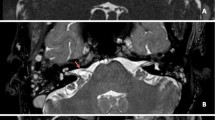Summary
Pathophysiological mechanisms responsible for intraoperative and postoperative hearing deficits associated with cerebellopontine (CP) angle operations were explored experimentally in dogs.
The CP angle operative manipulations performed were the same as those experienced by human patients, and auditory evoked potentials were monitored intraoperatively. As a result of the operative manipulations, petechial or confluent hemorrhages occurred at the compressed portions of the cochlear nerve, and intravascular clots were often observed. Disintegration of the nerve fibers was verified by ultrastructural examination. Moreover, rupture of the microvasculature within the cochlear nerve occurred at locations remote from the operative site, due to stretching of the nerve trunk.
The Obersteiner-Redlich zone, the Schwann-glial junction of the cochlear nerve, was a locus minoris resistentiae in CP angle surgery; the vasa nervorum easily bled at this zone and the peripheral and central myelins easily separated at their junctional zones (“central” avulsion injury).
Intracochlear hemorrhages were identified as the most probable cause of the sudden loss of all components of the auditory evoked potentials, a frequent predictor of postoperative hearing loss, although rupture, occlusion, or vasospasm of the main trunk of the internal auditory artery have also been implicated as possible causes of such hearing losses.
The results of this study show that hearing preservation is highly dependent on preserving not only the nerve at the operative site but also the remote O-R zone and intracochlear structures.
Similar content being viewed by others
References
Berthold C-H, Carlstedt T, Corneliuson O (1984) Anatomy of the nerve root at the central-peripheral transitional region. In: Dyck, PJ,et al, (eds) Peripheral neuropathy, Vol 1. W. B. Saunders, Philadelphia, pp 156–170
Eggermont JJ (1976) Analysis of compound action potential response to tone bursts in the human and guinea pig cochlea. J Acoust Soc Am 60: 1132–1139.
Gamble HF (1976) Spinal and cranial nerve roots. In: Landon DN (ed) The peripheral nerve. London: Chapman and Hall, London, pp 330–354
Hansen, CC (1971) Vascular anatomy of the human temporal bone. III. The vascularization of the vestibulocochlear nerve. Arch Klin Exp Ohr Nas Kehlk Heilk 200: 115–124
Hekmatpanah J, Hekmatpanah CR (1985) Microvascular alterations following cerebral contusion in rats. Light, scanning, and electron microscope study. J Neurosurg 62: 888–897
Henry KR, Choie RA (1979) Cochlear electrical activity in the C57BL/6 laboratory mouse: Volume-conducted vertex and round window responses. Acta Otolaryngol (Stockh) 87: 61–68
Itoh U, Spatz M, Walker JT, Jr, Klatzo I (1975) Experimental cerebral ischemia in mongolian gerbils. I. Light microscope observations. Acta Neuropathol (Berl) 32: 209–223
Jannetta PJ (1982) Cranial rhizopathy. In: Youmans, JR (ed) Neurological surgery, Vol. 6. W. B. Saunders, Philadelphia, pp 3771–3784
Jannetta PJ, Møller AR, Møller MB (1984) Technique of hearing preservation in small acoustic neuromas. Ann Surg 200: 513–523
Kimura RS (1973) Cochlear vascular lesions. In: Darin de Lorenzo AJ (ed) Vascular disorders and hearing defects. University Park Press, Baltimore, pp 205–218
Makishima K, Snow JB (1975) Pathogenesis of hearing loss in head injury. Arch Otolaryngol 101: 426–432
Møller AR, Jannetta PJ (1983) Monitoring auditory functions during cranial nerve microvascular decompression operations by direct recording from the eighth nerve. J Neurosurg 59: 493–499
Møller AR (1983) On the origin of the compound action potentials (N1, N2) of the cochlea of the rat. Exp Neurol 80: 633–644
Møller MB, Møller AR (1985) Loss of auditory function in microvascular decompression for hemifacial spasm. Results of 143 consecutive cases. J Neurosurg 63: 17–20
Nemecek S, Parizek J, Spacek J, Nemeckova J (1969) Histological, histochemical and ultrastructural appearance of the transitional zone of the cranial nerve and spinal nerve roots. Folia Morphol (Warsz) 17: 171–183
Obersteiner H, Redlich E (1894) Über Wesen und Pathogenese der tabischen Hinterstrangs-Degeneration. Arb Neurol Inst Univ Wien 1–3: 158–172
Ojeman, RG, Levine RA, Montgomery WMet al (1984) Use of intraoperative auditory evoked potentials to preserve hearing in unilateral acoustic neuroma removal. J Neurosurg 61: 938–948
Olsson Y (1984) Vascular permeability in the peripheral nervous system. In: Dyck PJ,et al (eds) Peripheral neuropathy, Vol. 1. W. B. Saunders, Philadelphia, pp 579–597
Raudzens PA, Shetter AG (1982) Intraoperative monitoring of brain-stem auditory evoked potentials. J Neurosurg 57: 341–348
Rhoton AL, Kobayashi S, Hollinshead WH (1968) Nervus intermedius. J Neurosurg 29: 609–618
Richardson PM, Thomas PK (1979) Percussive injury to peripheral nerve in rats. J Neurosurg 51: 178–187
Ross, MD, Burkel W (1971) Electron microscope observations of the nucleus, glial dome, and meninges of the rat acoustic nerve. Am J Anat 130: 73–79
Samii M (1985) Microsurgery of acoustic neurinomas with special emphasis on preservation of seventh and eighth cranial nerves and the scope of facial nerve grafting. In: Rand, RW (ed.) Microneurosurgery. C. V. Mosby Company, St. Louis, pp 366–388
Schuknecht HF, Woellner RC (1955) An experimental and clinical study of deafness from lesion of the cochlear nerve. J Laryngol Otol 69: 75–97
Sekiya T, Iwabuchi T, Andoh A, Kamata S (1983) Changes of the auditory system after cerebellopontine angle manipulations. Neurosurgery 12: 80–85
Sekiya T, Iwabuchi T, Kamata S, Ishida T (1985) Deterioration of the auditory evoked potentials during cerebellopontine angle manipulations: An interpretation based on animal experimental models. J Neurosurg 63: 598–607
Yasargil MG, Smith RD, Gasser JC (1977) Microsurgical approach to acoustic neurinomas. In: Krayenbühl H,et al, (eds.) Advances and technical standards in neurosurgery, Vol. 4. Springer, Wien-New York, pp 93–129
Yashon D (1978) Nerve root avulsion. In: Spinal injury. Appleton-Century-Crofts, New York, pp 255–260
Author information
Authors and Affiliations
Rights and permissions
About this article
Cite this article
Sekiya, T., Møller, A.R. & Jannetta, P.J. Pathophysiological mechanisms of intraoperative and postoperative hearing deficits in cerebellopontine angle surgery: An experimental study. Acta neurochir 81, 142–151 (1986). https://doi.org/10.1007/BF01401237
Issue Date:
DOI: https://doi.org/10.1007/BF01401237




